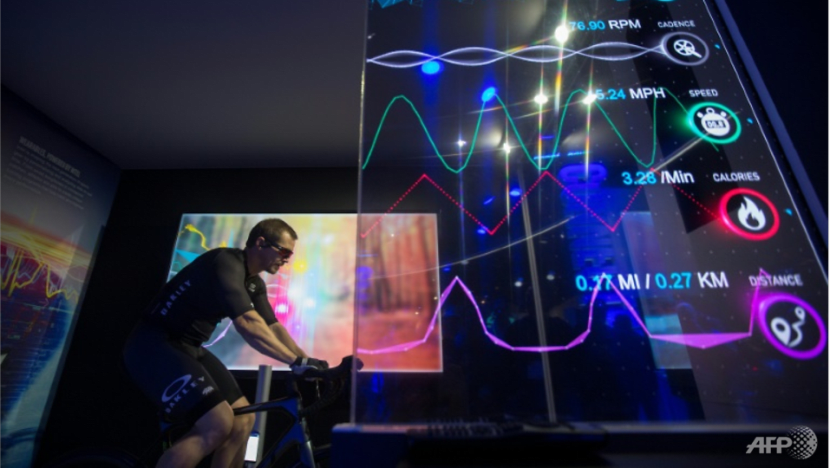Commentary: We're buying more fitness trackers but exercising less
Manufacturers of fitness trackers want us to believe they'll spur us to increase our physical activity levels and make us healthier, but research suggests otherwise, say professors.

File photo of a man tracking his fitness session via a wearable gadget. (Photo: AFP/DAVID MCNEW)
BOISE, Idaho: Worldwide sales of fitness trackers increased from US$14 billion in 2017 to over US$36 billion in 2020. The skyrocketing success of these gadgets suggests that more people than ever see some value in keeping tabs on the number of steps they take, flights of stairs they climb, the time they spend sitting and the calories they burn.
The manufacturers of these devices certainly want consumers to believe that tracking fitness or health-related behaviours will spur them to increase their activity levels and make them healthier.
Our analysis of research published over the past 25 years suggests otherwise.
To learn whether and how physical activity has changed in the years since fitness trackers became popular, we analysed more than two decades of research from several industrialised nations – all conducted before the COVID-19 pandemic.
Our systematic review of data from eight developed nations around the world shows that despite the surge in sales of fitness trackers, physical activity declined from 1995 to 2017. What’s more, we discovered that this was not an isolated effect in one or two countries, but a widespread trend.
SHARP DECLINES IN PHYSICAL ACTIVITIES
To conduct the study, we first searched for published research that tracked physical activity such as walking, household activities or playing sports throughout the day. We wanted studies that obtained two “snapshots” of daily activity from a population, with the measurements separated by at least one year.
We found 16 studies from eight different countries that met these criteria: Canada, the Czech Republic, Denmark, Greece, Japan, Norway, Sweden and the United States. The studies were conducted between 1995 and 2017.
It is important to note that these snapshots did not track specific individuals. Rather, they tracked samples of people from the same age group. For example, one Japanese study of physical activity among adults ages 20 to 90 collected data every year for 22 years from people in each age group.
Scientists tracked the participants’ physical activity using a variety of wearable devices, from simple pedometers – step counters – to more sophisticated activity monitors like accelerometers.
The study groups ranged from large, nationally representative samples numbering tens of thousands of people to small samples of several hundred students from a few local schools.
After identifying the research studies, we calculated an “effect size” for each study. The effect size is a method of adjusting the data to allow for an “apples-to-apples” comparison.
To calculate the effect size, we used the data reported in the studies. These include the average physical activity at the beginning and end of each study, the sample size and a measure of the variability in physical activity. Using a technique called meta-analysis, this allowed us to combine the results of all studies to come up with an overall trend.
We discovered that overall, researchers documented fairly consistent declines in physical activity, with similar decreases in each geographical region and in both sexes. Overall the decrease in physical activity per person was over 1,100 steps per day between 1995 and 2017.

Our most striking finding was how sharply physical activity declined among adolescents aged 11 to 19 years – by roughly 30 per cent – in the span of a single generation.
For instance, when we compared the studies reporting physical activity in steps per day, we found that the total steps per day per decade declined by an average of 608 steps per day in adults, 823 steps per day in children and 1,497 steps per day in adolescents.
Our study doesn’t address why physical activity has declined over the past 25 years. However, the studies we reviewed mentioned some contributing factors.
MORE SCREEN TIME, LESS OUTDOOR TIME
Among adolescents, declines in physical activity were associated with increases in ownership and use of smartphones, tablets, video games and social media. In the US, for example, screen time increased dramatically in adolescents, from five hours per day in 1999 to 8.8 hours per day in 2017.
At school, most of the physical activity that adolescents perform has traditionally come from physical education classes. However, the changes in the frequency of physical education classes during the study period are inconsistent and vary from country to country.
All of these factors may help to explain the decline in physical activity that we observed in our study.
Related:
In addition, fewer adults and children are walking or bicycling to school or work than 25 years ago. For instance, in the late 1960s, most US children ages 5 to 14 rode a bicycle or walked to school. Since then, this “active transportation” has largely been replaced by automobile trips. Rates of travel by school bus or public transportation have seen little change.
FITNESS TRACKERS ARE STILL USEFUL
So if levels of physical activity have dropped at the same time that the popularity of fitness tracking has grown, what makes these gadgets useful?
Fitness trackers can help to increase people’s awareness of their daily physical activity. However, these devices are only part of the solution to addressing the problem of sedentary lifestyles. They are facilitators, rather than drivers, of behaviour change.
When a person’s physical activity goes down, it opens the door to overall reduced fitness levels and other health problems such as obesity or diabetes. On the other hand, physical activity has a dramatic positive impact on health and well-being.
The first step to increasing active movement is to measure it, which these devices can do. But successfully increasing one’s overall physical activity requires several additional factors such as goal-setting, self-monitoring, positive feedback and social support.
Scott A Conger is an Associate Professor of Exercise Physiology at Boise State University, David Bassett is a Professor and the Department Head of Kinesiology, Recreation and Sport Studies at the University of Tennessee, and Lindsay Toth is an Assistant Professor of Kinesiology at the University of North Florida. This commentary first appeared in The Conversation.
















